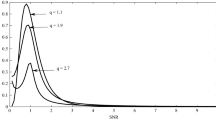Abstract
This paper formulates a finite-state Markov channel model to represent received signal-to-noise (SNR) ratios having lognormal, K-distribution, chi-square (central) and chi-square (non-central) distributions in a slow fading channel. The range of the SNRs is partitioned into a finite number of states following earlier works in literature. Performance measures like level crossing rates, steady-state probabilities, transition probabilities, and state-time durations are derived, and numerical results are plotted and discussed for the FSMC models for all the distributions.















Similar content being viewed by others
References
W. Turin, Digital Transmission Systems: Performance, Analysis, and Modelling, 2nd ed. McGraw-Hill, NY, 1999.
W. Tranter, K. Shanmugan, T. Rappaport, and K. Kosbar, Principles of Communication Systems Simulation with Wireless Applications, Prentice Hall, Inc., July, 2003.
S. Kundu, K. Basu, and S. Das, Finite-state Markov model for effective bandwidth calculation in wireless packet networks, Third International Symposium on Modeling and Optimization in Mobile, Ad hoc, and Wireless Networks (WiOpt ’05), pp. 351–357, 2005.
W. Tang, Finite-state Markov models for correlated fading channels in wireless communications. Technical report, University of Pennsylvania, 2001.
R. Chen, K. Chua, B. Tan, and C. Ng, Adaptive error coding using channel prediction, Journal of Wireless Networks, Vol. 5, No. 1, pp. 23–32, 1999.
C. Iskander and P. Mathiopoulos, Fast simulation of diversity Nakagami fading channels using finite-state Markov models. IEEE Transactions on Broadcasting, Vol. 49, No. 3, 2003.
J. Yun and M. Kavehrad, Markov error structure for throughput analysis of adaptive systems combined with ARQ over correlated fading channels, IEEE Transactions on Vehicular Technology, Vol. 54, No. 1, pp. 235–245, 2005.
A. Ramesh, A. Chockalingam, and L. Milstein, A first-order Markov model for correlated Nakagami-m fading channels. Proc. IEEE GLOBECOM ’02, 2002.
P. Sadeghi and P. Rapajic, Capacity analysis for finite-state Markov mapping of flat-fading channels, IEEE Transactions on Communications, Vol. 53, No. 5, pp. 833–840, 2005.
H. Rutagemwa and X. Shen, Modeling and analysis of WAP performance over wireless links. IEEE Transactions on Mobile Computing, Vol. 2, No. 3, pp. 221–232, 2003.
H. S. Wang and P. Chang, On verifying the first-order Markovian assumption for a Rayleigh fading channel, IEEE Transactions on Vehicular Technology, Vol. 45, No. 2, pp. 353–357, 1996.
M. Zorzi, R. Rao, and L. Milstein, On the accuracy of a first-order Markov model for data transmission on fading channels. Fourth IEEE Conference on Universal Personal Communications, pp. 211–215, 1995.
J. G. Proakis, Digital Communications, 4th ed. McGraw Hill, NY, 2001.
T. Moulsley and E. Vilar, Experimental and theoretical statistics of microwave amplitude scintillations on satellite downlinks, IEEE Transactions on Antenna Propagation, Vol. 30, pp. 1099–1106, 1982.
J. Parsons, The Mobile Radio Propagation Channel, Wiley, Inc., NY, 1992.
L. Kanal, A. Sastry, Models for channels with memory and their applications to error control, Proceedings of the IEEE, Vol. 66, No. 7, pp. 724–744, 1978.
G. L. Stuber, Principles of Mobile Communication, Kluwer Academic Publishers, Dordrecht, Netherlands, 1996.
Q. Zhang and S. Kassam, Finite-state Markov model for Rayleigh fading channels, IEEE Transactions on Communications, Vol. 47, No. 11, pp. 1688–1692, 1999.
W. C. Jakes, Microwave Mobile Communications, 1st edn. John Wiley & Sons, Inc., MA, 1974.
H. S. Wang and N. Moayeri, Finite-state Markov channel—a useful model for Radio communication channels, IEEE Transactions on Vehicular Technology, Vol. 44, No. 1, pp. 163–171, 1995.
C. D. Iskander and P. Mathiopoulos, Finite-state Markov modeling of diversity Nakagami channels. Proceedings of the 7th Canadian Workshop on Information Theory, 2001.
A. Abdi and M. Kaveh, Comparison of DPSK and MSK bit error rates for K and Rayleigh–lognormal fading distributions, IEEE Communication Letters, Vol. 4, pp. 122–124, 2000.
I. Gradshteyn and I. Ryzhik, Table of Integrals, Series, and Products, 5th ed. Academic Press, San Diego, CA, 1994.
Author information
Authors and Affiliations
Corresponding author
Rights and permissions
About this article
Cite this article
Bhaskar, V. Finite-state Markov Model for Lognormal, Chi-square (Central), Chi-square (Non-central), and K-distributions. Int J Wireless Inf Networks 14, 237–250 (2007). https://doi.org/10.1007/s10776-007-0065-2
Received:
Accepted:
Published:
Issue Date:
DOI: https://doi.org/10.1007/s10776-007-0065-2




